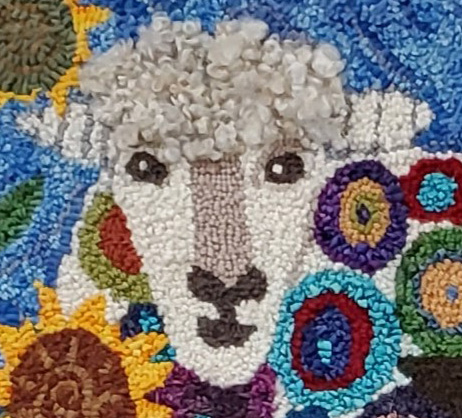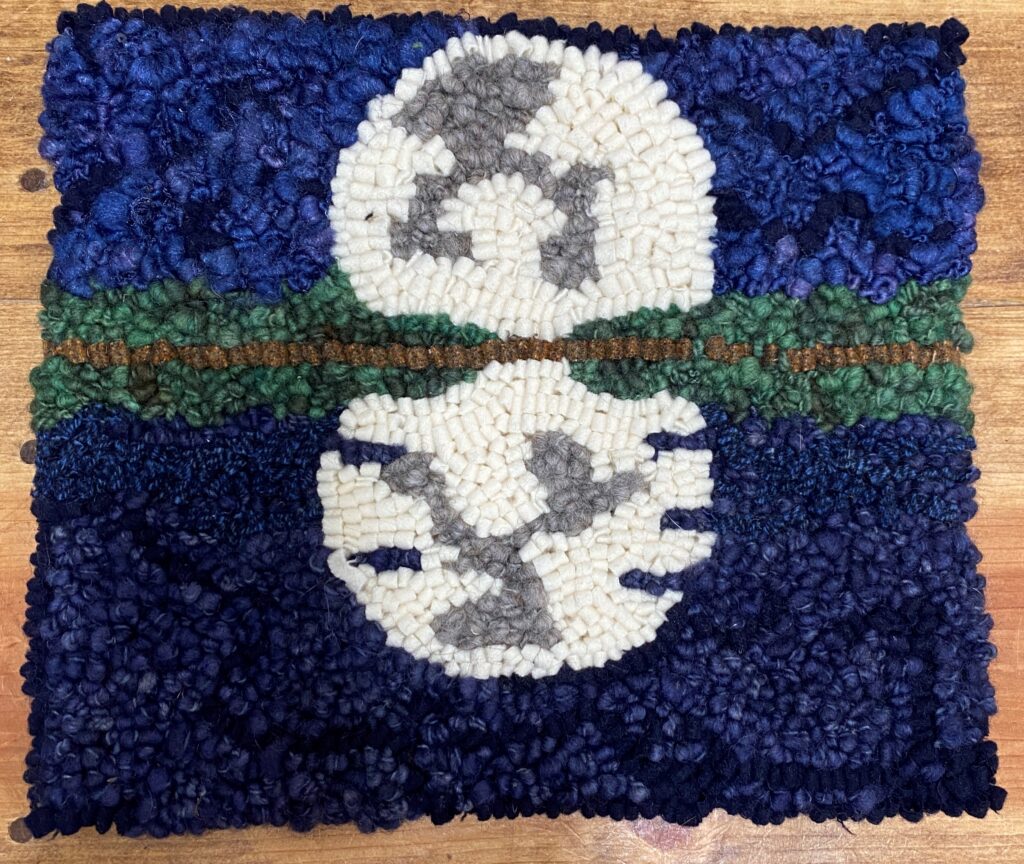It is my pleasure to share with you this wonderful article by Mary about her use of art yarns and textures to create these fantastic art pieces. I am sure this will get you thinking about your stash differently and inspire you to try this out too! I really like Mary’s use of a traditional technique to which she has added her own ‘spin’ by using unusual materials and inspirations.
You can find Mary online at Fancy Fibers on Facebook (https://www.facebook.com/FancyFibersStudio) and at the Fancy Fibers website: https://www.fancyfibers.com – I recommend visiting!
Suzy
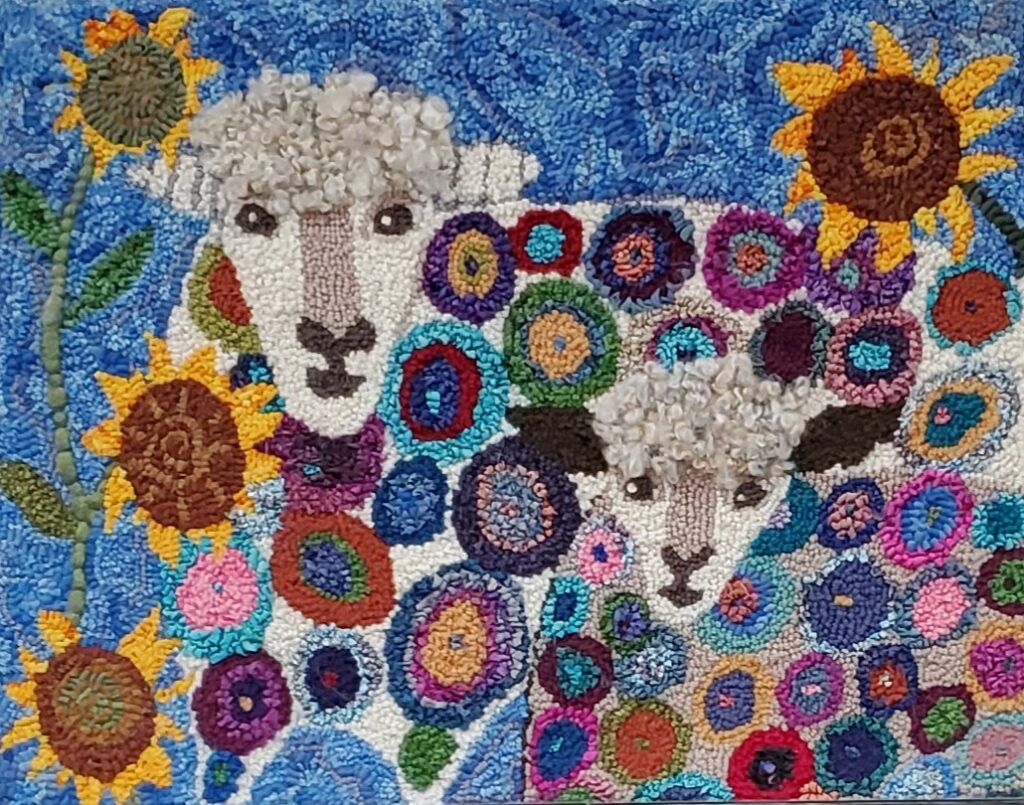
My name is Mary Berry and I am a spinner, weaver, dyer, and rug hooker. I teach those fiber arts in my shop in the little town of Farmersville, Texas, USA. I am 65 years old and have worked in fiber arts for 40 years.
____________________________________________
One thing I can say with great confidence is that whatever fiber art you’ve done “before” will inform and elevate the fiber art you are doing both now, and later. In this case, my spinning is taking my rug hooking in a new direction.
It was with this thought in my heart and head that I started rug hooking using my handspun yarn, more specifically my fun “lumpy bumpy” yarn. Rug hooking has a proud and long history of developing and thriving in the United States. Prior to the invention of mill-made carpets, only the wealthy could afford to have rugs shipped from England to warm their floors. But the other classes were not to be left out. Industrious women used flour sacks and scraps of leftover clothing, too worn and too small for any other use, to hook rugs for their floors.
Rug hooking is alive and well, both as rugs for the floor and rug art to hang on the wall. What was once a craft born from necessity, is now an artistic pastime. Materials are much better than they were in the past, and modern designs are often based on aesthetics. There are various categories of rug styles (primitive or modern styles, for example). Rug hooking is a craft that is available to everyone.
What You Need
Rugs are hooked onto a foundation fabric. These fabrics are specifically woven for rug hooking and include burlap, carpet warp (a rugged cotton material), primitive linen, and bleached Scottish linen. I hook either on Scottish Linen or a style of primitive linen that is woven with both white and natural yarns. Most primitive linen is woven with only natural colored yarn and I find it harder to see my pattern on those fabrics.
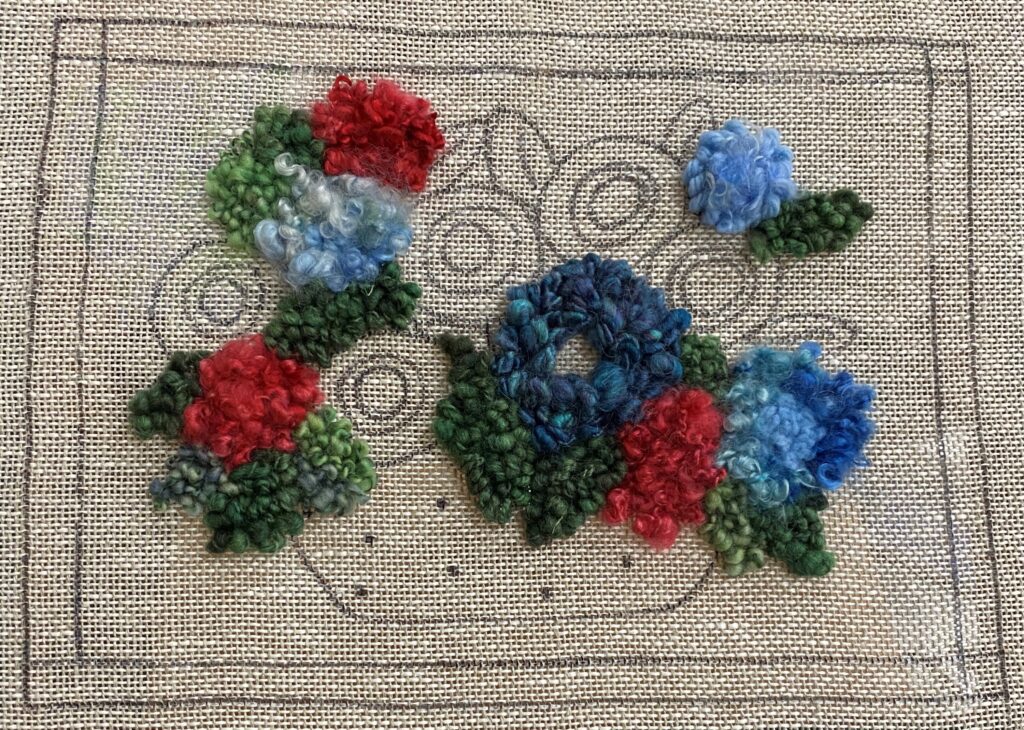
For a floor rug, you will need 100% wool yarn and/or fabric. Traditional rug hookers use wool fabric that has been specially woven for rug hooking. Savvy shoppers find wool skirts at the thrift store, wash and dry them in the washing machine, then disassemble them. They must be washed and dried to full the fabric enough to cut it into strips for hooking.
For a wall hanging, basically anything goes! Wool is still preferable to cotton, but you can also include novelty yarns, acrylic yarn, sari silk, metallic ribbon, anything you can find in a worsted or bulky weight. Novelty yarns are typically combined or hooked with a heavier yarn. Wall art is where the rug hooking fun begins for spinners! If you can get it through the holes in the foundation fabric, or couch it on top as an accent, you can use it.
If you use wool fabric, it must be cut into strips about a yard long. There are strip cutters specifically for this purpose and “cuts” range in size anywhere from 2/16 of an inch up to 1/2 inch. If you aren’t using much fabric, you can get by with a rotary cutter.
Additional equipment includes a rug hooking stand and a hook. Sometimes a large embroidery stand will do. The foundation fabric must be held very taut for hooking.
When purchasing a hook, look for one with a tapered shaft, smaller at the hook end and tapering to a larger size. Being able to push the hook down far enough to make a big hole to draw your yarn through is an important plus!
Finally, you will need a pattern (or not). Rug hooking patterns are available from many shops on the internet. Alternatively, you can draw your own or start from a photograph as your inspiration.
Patterns are available already drawn on linen, or you can use a light table (a glass table with a light underneath it) to trace the pattern on your own foundation cloth. For hooking with art yarn specifically, it is a good idea to keep the pattern simple. And remember: the pattern is just a suggestion; you can follow it or use it as a guideline.
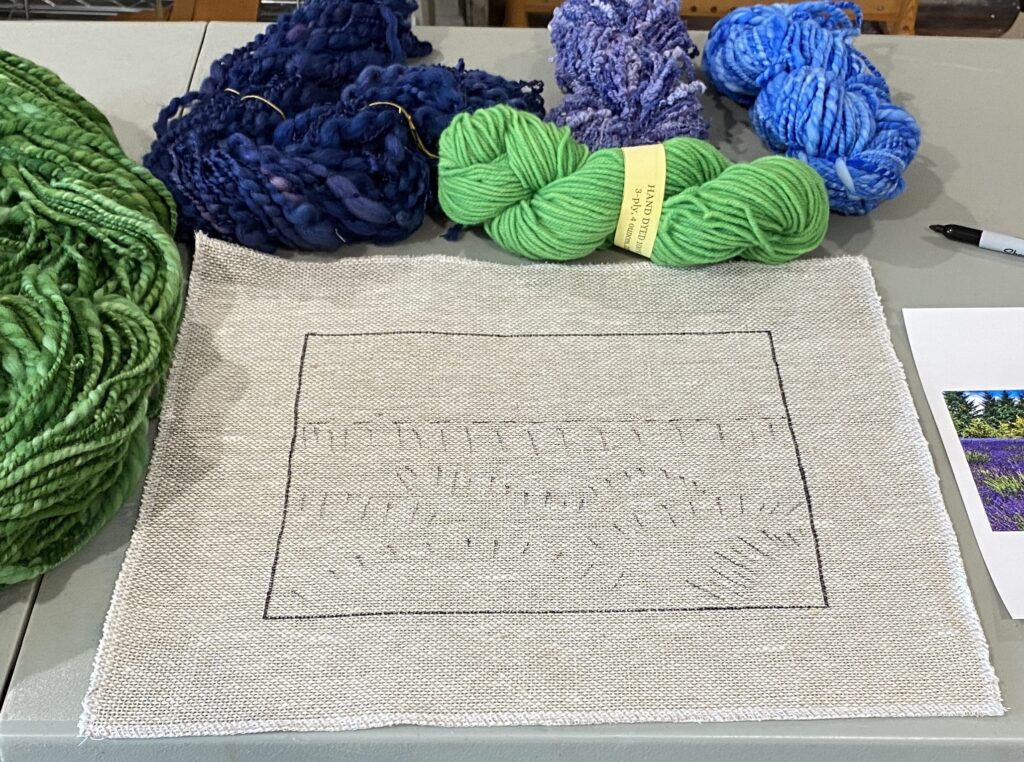
The act of rug hooking is deceptively simple. Hold a strip of fabric or yarn underneath the foundation material (which has been stretched taut on a rug hooking stand) and pull up a loop. Then you move over and pull up another loop from the same strip. When you get to the end of the strip you can pull up the end and cut it to match the height of the loops. To add your next strip, bring the new strip up through the same hole your last strip just ended on. Continue in the same way until the area is covered in loops, following the pattern, filling in each area and following the lines on your fabric, something like coloring in.
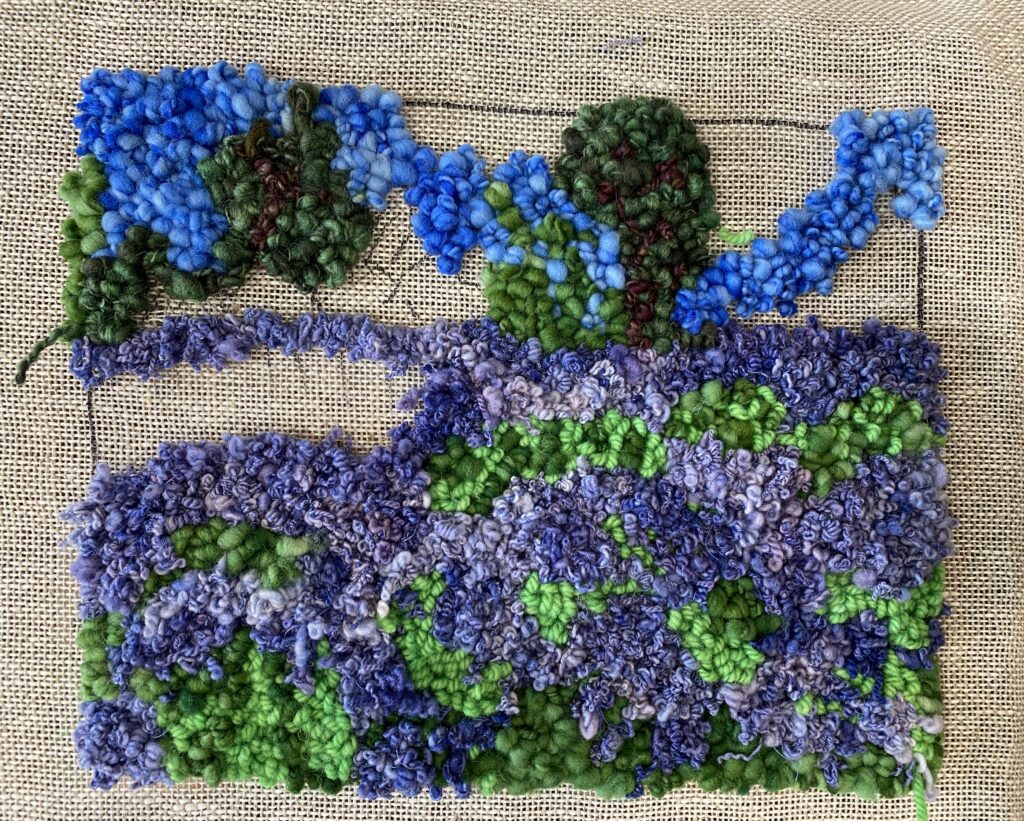
My Rugs
The Sheep Rug pictured above (which is actually a wall hanging) is a great example of using anything and everything in your art. The design is by Karla Gerard, one of my favorite designers. She sells her designs as black-line drawings on eBay, and you can have them enlarged to whatever size you want to make. In this rug, you will notice that I hooked the sheep top knots with big and bulky hand spun Teeswater. Using my tapered hook, I pulled the yarn up high from the bottom and let it settle on the top of the foundation. This is a good rule for art yarn: If your yarn is fat and curly, pull it up high! You do not need to hook in every hole. In fact, every third hole or forth hole may be fine. Hook just enough to cover the area and stop. No need to crowd fluffy yarn either!
You’ll also notice in the sheep rug that I dyed a piece of core spun alpaca green, laid it on top of the foundation cloth, and couched it to the surface with green thread. It is secure and makes a great stem for the sunflower it is holding up.
Lavender Fields is a small wall hanging that was perfect for some lavender wool bouclé yarn I had. I searched the internet for the picture of a lavender field, then sketched a pattern on my primitive linen. The bouclé yarn is the flowers, and various thick and thin yarns make up the trees, bushes, plant stems, and sky. One thing to remember when choosing a yarn is to find one that is the appropriate size for the proportions of the piece you are hooking. A super large yarn would look out of place and not be shown to its full effect in a small project. As with the sheep top knots, I pulled the bouclé yarn up high, and let it rest on the foundation cloth.


The Worm Moon was inspired by a picture as well. When you use an inspiration picture, you do not need to try to make your piece look just like the photo you are working from. You are not recreating the image, but are rather interpreting the image in a different medium. Also remember that small details can be difficult to show unless you are willing to use very small cuts of wool fabric. Nevertheless, this piece was fun! I used a big thick and thin yarn that had been plied with sequined yarn for the sky, a thick and thin green that had been overdyed different shades of green for the shrubs, a grey thick and thin for the clouds in the moon, and both fabric strips and another darker blue thick and thin for the water. If you are coming to the conclusion that I really like thick and thin yarn to add texture to my rug hooking, you are correct!
The Flower Basket started as another Karla Gerard pattern. I love her art! While I did hook come of the flowers with hand spun yarn as the outer ring and commercial bulky wool yarn as the inside, most of the flowers are hooked solely using my handspun yarn. For this piece, I used the same greens for the leaves, tail spun mohair for the blue and red flowers, a little bit of the lavender bouclé yarn, a sparkly big thick yarn, and a bulky single beaded yarn.
I used two different methods to hook the beaded yarn. The smaller oblong beads were easy to pull up through the primitive linen once I made a big hole with my tapered hook. However, there was no way the larger bead was going to come up from the bottom! I started by setting the bead in place as the center of the flower, then pulled the yarn tails on either side of the bead down through the fabric. Once the tails were underneath, I could pull them up in loops around the large bead.
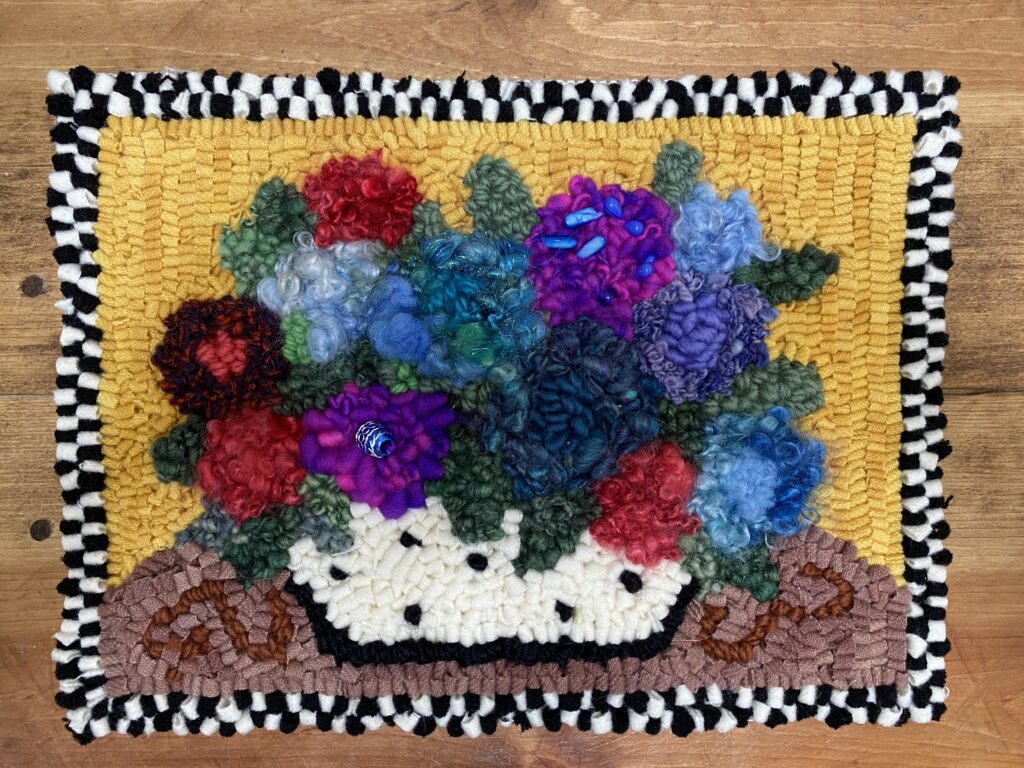


What I have shown are some straight-forward techniques that use bulky yarns. Just imagine what you could make with super bulky yarns in a large piece! They typically will not pull through the fabric, but they can certainly be couched on the top with smaller yarns and/or fabric strips hooked through the foundation and providing the base. I hope you will try rug hooking as a method of showing the beauty of your handspun yarn.
For a simple and quick tutorial on How to Rug Hook, watch How to Rug Hook from Deanne Fitzpatrick on You Tube at https://youtu.be/dFkqnT8Czng.)

